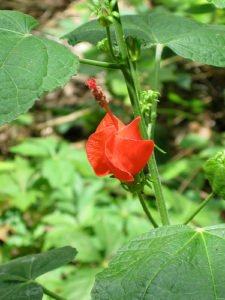
Turk’s Cap A Deciduous Perennial Shrub
Malvaviscus arboreus Malvaviscus is from a Greek word meaning “sticky mallow”.
mal-vah-VISS-kus ar-BOR-ee-us
Turk’s cap was designated a 2011 Texas Superstar because when it comes to climate and soils, it is a very tough versatile plant. It is native to South Texas, and is a magnet for butterflies and hummingbirds. It is a very versatile plant and easy to propagate. It’ll grow in full sun, full shade, wet soil, dry soil, alkaline soil and acid soil. The plants are perennial in Zones 7 to 11. The plant becomes progressively more “shrub-like” the further south one goes. It’s an old garden plant that’s found at old-home sites and in old gardens. Gardeners passed along clippings to relatives and friends down through several generations.
Turk’s cap has dark green leaves and cherry-red or white flowers that look like miniature Turkish turbans. Turk’s cap leaves may become lighter green and take on a more quilted appearance in very sunny locations. It can be grown easily from seed.
Its name is derived from the shape of the small blooms it produces continuously from early summer through late fall. A pistil protrudes above the petals that are loosely rolled to somewhat resemble a delicate rosebud. The dark green heart-shaped leaves of this hibiscus family member are large and provide an interesting contrast to the brilliantly colored flower. Its vermillion red flowers are twisted into a tube showing extended red stamens protruding from the whorl.
You can harvest the flowers, fruit, and young leaves. It has red fruit resembling rose hips in the late summer. The marble-size red fruit is edible, having a mealy taste, and is enjoyed by a number of birds and animals. Eat flowers and young leaves raw or cooked; flowers can make pink lemonade type drink; fruit can be made into tea or preserves. The flowers and fruit make a good herb tea. The fruit is edible either raw or cooked, tasting rather like apple, hence its Spanish name, Manzanilla (Little Apple). The fruit is full of pulp and seed; cooked down, it produces a good jelly or syrup. The flavor of the raw fruit resembles that of watermelon or apple.
Nutritional Value: Flowers high in antioxidants; seeds are high in protein & starch; leaves high in minerals; fruit high in vitamin C
Its leaves have been used as an emmolient and in Mexico the flowers are used in a decoction to treat inflammation of the digestive tract and as a menstrual aid.
A well-established Turk’s Cap is difficult to dig up due to its very tough, dense and deep roots.
